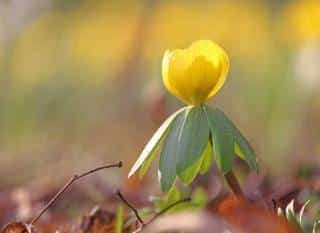

Rocky gravel beds often look a bit drab in winter and at the beginning of springs. Perennials are still dormant, just barely starting to bud. Small spring bulb flowers – be they botanical varieties or more classic ones – have an uncanny ability to thrive in this type of context.
Fall is when you have to remember to put the bulbs in the ground, so that they can take root before it freezes. Try to plant them 3 weeks before the earliest frost dates.
The white color of its bells, with their cute green dashes and dots, makes flowers beds feel bright and lively, seeming to answer back to any snow that hasn’t yet melted away. Don’t delay, plant these as soon as you purchase them. Place large numbers of them together – several dozens at the very least – and the result will look spectacular.
 Snowdrop favors cool, clayish soil, eventually amended with peat. It will do just as well in full sun and in part shade. When clumps grow to dense and tight, dig them out right after the blooming, and plant them back further apart immediately. Snowdrop will help create very beautiful gardenscapes at the foot of rock garden conifers, or with other dark-colored ground cover perennials such as ivy or alpine rock cress. The 6 to 8 inch stems (15 to 20 cm) won’t have any trouble surging through the ground cover plant.
Snowdrop favors cool, clayish soil, eventually amended with peat. It will do just as well in full sun and in part shade. When clumps grow to dense and tight, dig them out right after the blooming, and plant them back further apart immediately. Snowdrop will help create very beautiful gardenscapes at the foot of rock garden conifers, or with other dark-colored ground cover perennials such as ivy or alpine rock cress. The 6 to 8 inch stems (15 to 20 cm) won’t have any trouble surging through the ground cover plant.
The small golden cups ,circled with a bright green rosette truly enhance snowy landscapes and leaf-covered areas with dots color as early as January-February. The flower looks like a spitting image of the cute buttercup flower, the only difference being that it blooms so low on the ground because the stem is short. Plant Eranthis hyemalis or winter aconite higher up so that you can easily look at the cute flowers and smell its divine scent!

For this plant, choose full sun exposure, or part shade.

T. turkestanica is slender and elegant. Its 8-inch stems (20cm) bear 5 to 8 star-shaped cream-colored corollas with dashes of yellow. Early March is when both bloom.

Best plant them in full sun in a spot where the soil is cool in spring but drains well. Press the bulb down about 4 inches deep (10 cm), so that it doesn’t dry off in the summertime.
>> To learn more, read:

They bloom very early in spring, even before setting out any leaves from the sheath they overwintered in.
Iris danfordiae has a fragrant, bright yellow corolla, whereas reticulata displays various shades of blue and violet, dotted with white and orange dashes that look like a patient painter hand-painted them.

This small bulb hailing from the mountains of Turkey shines its thin-petaled purple corollas when snow starts melting away. Its white heart is truly a gift! One species in particular, luciliae never exceeds 6 inches (15 cm). It is simply perfect to fill in a miniature valley landscape, sided by moss-covered rocks. The blooming occurs at the end of March – beginning of April with 2 to 3 flowers per stem. It lasts about 2 weeks. Cultivated variants usually come from another species: C. forbesii. The stems of these cultivars are a bit taller, about 8 inches (20 cm), and bear a dozen flowers each.

Plant this in light, rich soil with lots of organic matter, either in the sun or in part shade. Cold climates suit it best.
>> To learn more, read:
Vast swaths of Siberian squill will always stand out with their unique blue hue. Flowers appear in loose clusters on 6-inch tall scapes (15 cm), over the first half of spring. Plant bulbs in groups, it’ll reach the end result of cover the ground faster. Propagation occurs naturally through bulblets and through seeds. Leaves quickly wilt away after the blooming.

Pair it with Erythronium americanum which has pale yellow flowers.
Crocus, Narcissus and botanical tulip (like Tulipa polychroma, turkestanica), Ipheion uniflorum, Anemona blanda, Grape hyacinth, Puschkinia, Cyclamen coum, Erythronium pagoda, Leucojum vernum…